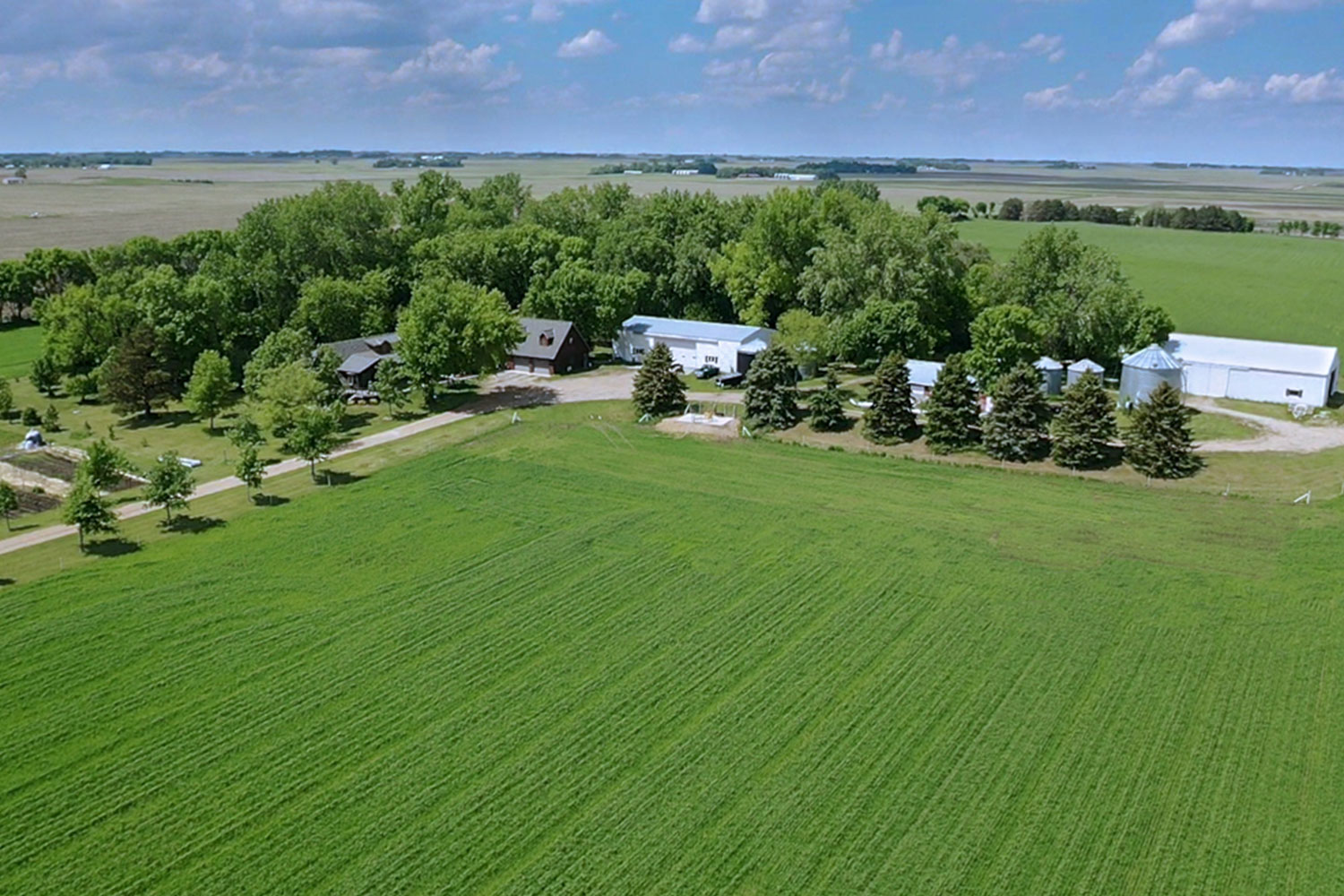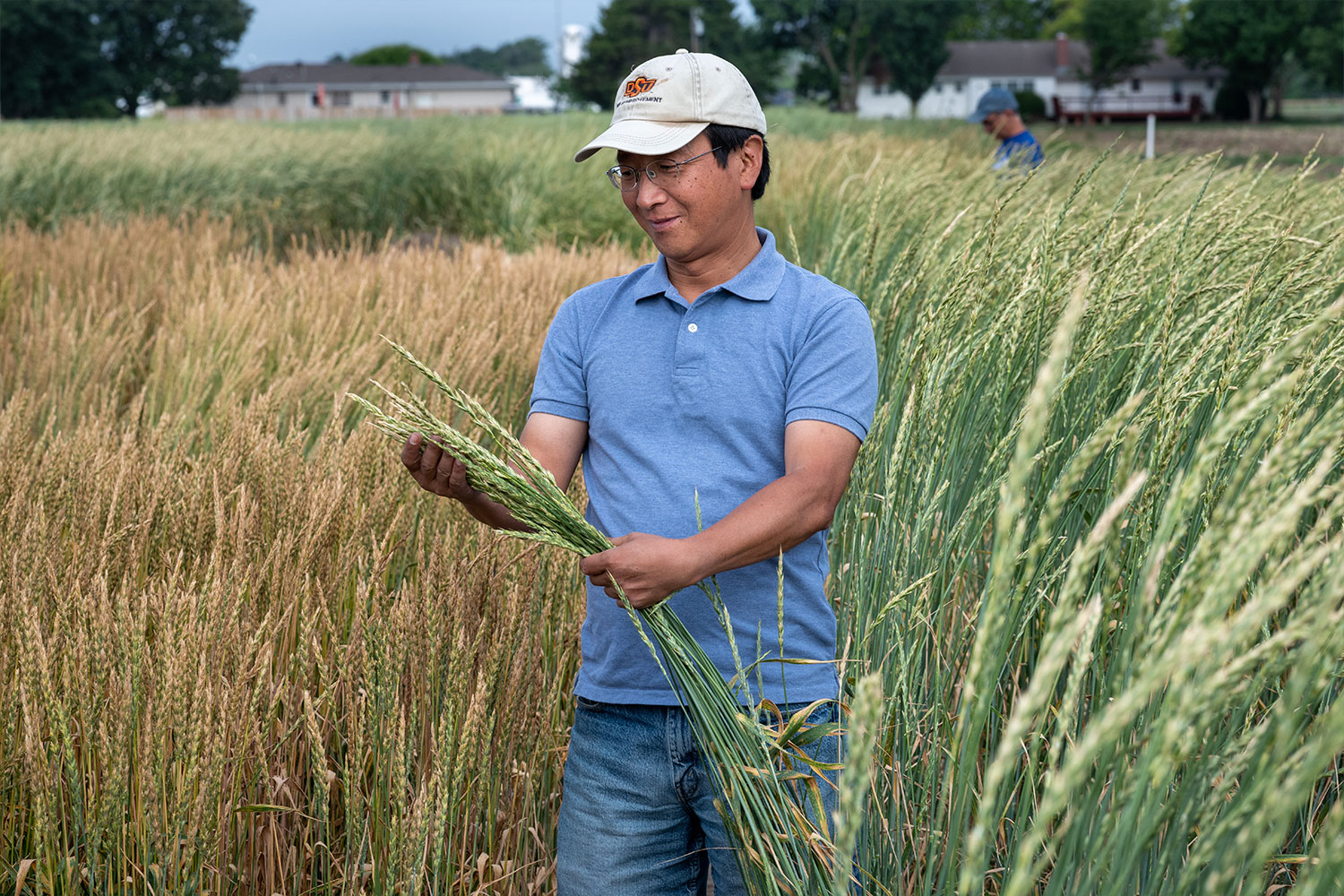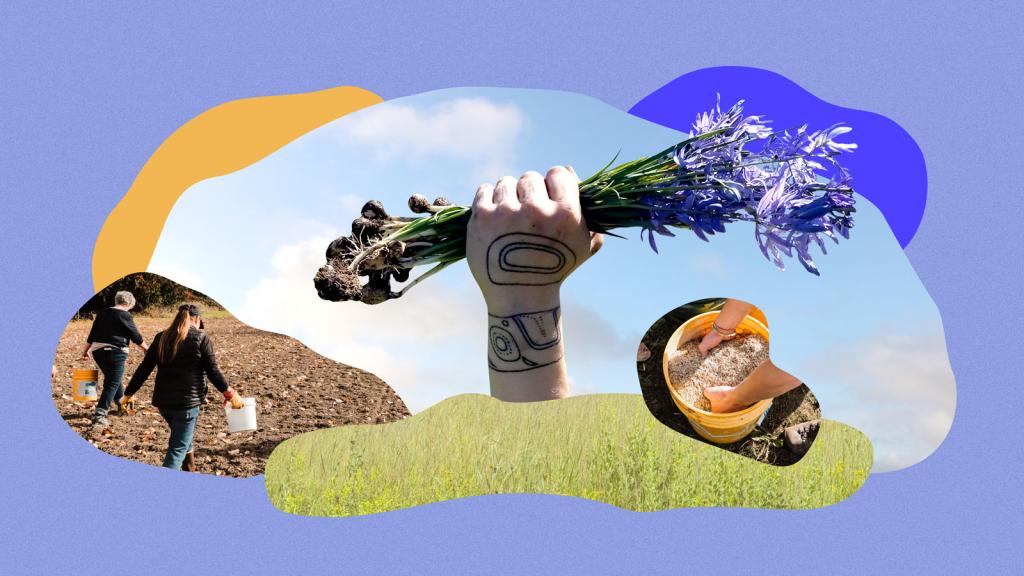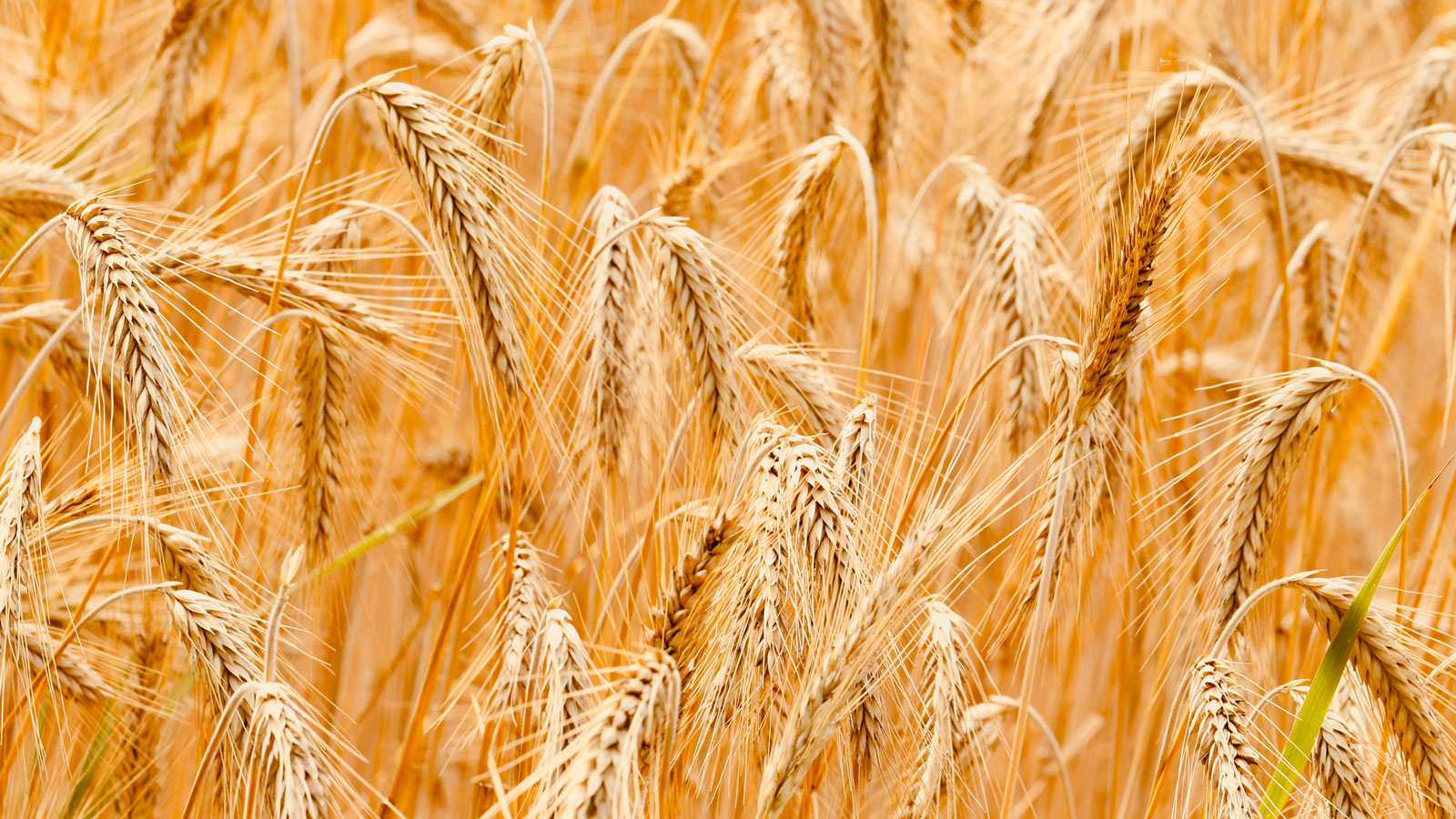As our climate changes, so will our diets. Fix’s Future of Food Issue explores that reality through the lens of foods that show what sustainable, equitable, and resilient eating could look like. Try them yourself with the recipes in our Climate Future Cookbook.
There’s a bucolic beauty to Carmen Fernholz’s farm in Madison, Minnesota. Exploring his 400 acres near the state’s western edge means traversing fields of corn, soybeans, barley, buckwheat, and alfalfa.
Not far away, cover crops of red clover, purpletop radish, and yellow sunflower blanket the land alongside a pasture where cows graze and naturally fertilize the soil. His daughter Katie tends a vegetable garden and recently planted pear, cherry, and hazelnut trees. Another 50 acres that’s been set aside as wetland and restored prairie provides a verdant habitat for deer, pheasants, and other wildlife. Early each morning, the air is alive with insects and birds. “This time of year, you can smell the pollen from the corn,” says Fernholz. “And in the springtime, we’ve got lilacs planted along our fence line, and you have the light breezes and the smell of lilac in the air.”
Further afield, you come across 150 acres of a crop that, though seemingly unimpressive, is helping reverse the damage wrought by modern agriculture and climate change: a perennial grain called Kernza. Don Wyse, an agronomy professor at the University of Minnesota, approached Carmen in 2010 to ask if he’d be interested in growing something that would enhance soil and water quality on his organic, regenerative farm. Fernholz readily agreed. “Learning through experience and experimentation has always been exciting for me, but also learning about what the potential for this crop is,” he says.
Almost all the wheat cultivated in the U.S. is an annual variety, meaning it must be planted anew every year. That requires tilling the soil, destroying the ecosystem within. Perennial crops, on the other hand, are sown, harvested from, and allowed to continue growing year after year. Because the soil sustaining them remains undisturbed, the roots reach deep into the earth, enriching a microbial world as diverse and rich as coral reefs.
A thriving soil ecosystem stores a lot of carbon dioxide, helping offset climate change. Tim Crews, a soil ecologist for the nonprofit agriculture-research organization The Land Institute, says the root systems of perennial crops pull in “far more carbon” than those of annuals because they’re much larger and deeper. They then leech as much as half of that carbon into the ground, feeding microbes like fungi, bacteria, and nematodes, which in turn provide nutrients to crops. Soil hosting perennial crops retains those nutrients and water more efficiently, making the ecosystem more resistant to increasingly common droughts, floods, and erosion. It also absorbs fertilizers and pesticides more effectively, minimizing runoff into watersheds.

Given that, farmers, field researchers, and others dedicated to sustainable agriculture are experimenting with perennial crops. Kernza, the domesticated wild perennial grass growing on Fernholz’s spread, is the most famous of them. It already appears in bread, beer, and other products. Others, like perennial wheat, are gaining ground. It will be many years before they are widespread, but even now they are restoring a measure of ecological stability to the land.
Their success will require a cultural shift and a rethinking of how the U.S. government supports agriculture, but such changes are taking root. “When I look back from 2011 until now and see how interest is growing, how acreage is growing, and how buyers are really becoming interested in it,” Fernholz says. “Those are the things that keep me going and wanting to do more and more along these lines.”
A sustainable grain system resembles a prairie, which, like most natural ecosystems, is a perennial polyculture. This landscape began to change with the dawn of the Agricultural Revolution some 10,000 years ago when humanity domesticated livestock and planted monocultures that grew quickly and produced high yields. Today, grains like wheat, corn, and rice cover 70 percent of the world’s cropland and account for 70 percent of the calories consumed worldwide. The immense scale of industrial agriculture has made it one of the leading causes of carbon emissions, deforestation, and biodiversity loss.
[Read more: How Indigenous tribes are restoring prairies in the Pacific Northwest.]
Today, just 3 percent of North America’s tallgrass prairie remains. Much of it was plowed under to create farmland. Crews says this released as much as 70 percent of the carbon that had been accumulated over millennia and, in time, robbed the land of its microbial life and nutrients. “If you take a perennial grain and you replace those annuals, you all of a sudden create the conditions that built the organic material that was lost,” he says. “If we converted the annual crops back to perennials, you would be able to accumulate a lot of that carbon that is currently up in the atmosphere.”

In Salina, Kansas, The Land Institute is one organization calling for the agriculture industry to embrace perennial grains. It developed Kernza by domesticating intermediate wheatgrass, a perennial related to annual wheat, to essentially create a new strain. Intermediate wheatgrass typically isn’t grown for food because it has smaller seeds, and thus a lower yield, than annual varieties. But plant breeders and geneticists at the institute have been selectively breeding the plant to maximize seed size, which has doubled in the 20 years since the project began. (Think of Kernza as a golden retriever bred to have the best coat and disposition.) That’s boosted yields, making the plant economically viable. Two years ago, the Department of Agriculture gave The Land Institute, the University of Minnesota, and several other organizations $10 million to scale up cultivation of Kernza, which is one of six perennials the institute is working on.
Meanwhile, scientists at the organization are also breeding perennial wheat by crossing annual wheat with its perennial cousin, wheatgrass — much like the Labradoodle is the result of breeding a Labrador retriever with a poodle. The goal is to create a hybrid that provides the yield and seed quality of annual wheat but does not require planting anew each year.
The new grain is still in the early experimental stage in the institute’s research fields. Shuwen Wang, the project’s lead scientist, is focused on breeding a crop that survives at least three years and provides the same number of harvests. So far, it has endured for two years and provided that many harvests. He’s also exploring the possibility of planting perennial wheat with legumes like alfalfa, which help keep nitrogen in the soil. The strategy could also suppress weeds, reducing the need for herbicides and fertilizers.
* * *
An economically viable variety of perennial wheat with a yield like annual wheat won’t be available for another 10 to 20 years, but The Land Institute already is introducing farmers to the crop. It has, since September 2021, had 100 people it calls “civic scientists” in 40 states growing perennial wheat in garden-sized plots. They’ve been collecting data on the plant’s growth after harvesting seeds, its survival rate through cold winters and hot summers, and its resistance to disease.
“If we converted the annual crops back to perennials, you would be able to accumulate a lot of that carbon that is currently up in the atmosphere.”
— Tim Crews, soil ecologist
Maret Felzien, a fourth-generation farmer and educator in Sterling, Colorado, is among those testing perennial wheat. She planted 20 seeds on a section of her land — which includes annual wheat, corn, and other crops along with cattle — dedicated to native grasses. The crop fared much better than the annual wheat and Kernza cultivated alongside it as a control group. “Interestingly enough, the perennial wheat sprouted the best of all,” she says. Five of the plants survived the winter and made it to harvest. Not bad, all things considered.
“It’s been a tough year to grow anything,” due to drought, Felzien says. “But when you put on your scientist hat, it’s been a great year because now we know what happens with perennial grains in dry, dry land.”
Aubrey Streit Krug, who oversees the civic science program, says The Land Institute is still analyzing results from these 100 locations and plans to share them in October. “Those results will be really helpful to our perennial-wheat breeding team,” she says.
The ongoing effort, coupled with some good news in October, could boost public understanding and appreciation of the crop and create the social conditions necessary to ensure its success when it’s ready for widespread adoption. “We’re opening up possibilities for people to build relationships with these future perennial grains from the ground up, and building a kind of culture and story around these crops,” says Streit Krug. “Integrating the science, community, and story in this kind of research process is really exciting to me.”
* * *
Many of Kernza’s early adopters have started experimenting with processing perennial wheat, an experiment that will unfold much like it has with Kernza, the only perennial grain currently grown in quantities large enough to mill. As the founder of Perennial Pantry, a grain processor and food producer in Burnsville, Minnesota, Christoper Abbott is at the forefront of these efforts.
Being from the Midwest, Abbott felt a responsibility to reimagine how grain is grown after becoming involved with local food movements. “In 2010, when I started engaging with this, you could point at large-scale agriculture as the problem and the solution would be local veggies,” he says. “Local veggies are great and part of the conversation, but I was really interested in how to think about this massive use of land that grains dominate right now and try to reimagine that into a system that’s not so destructive of rural communities, soil, climate, and water.” He launched Perennial Pantry in 2020.
Farms throughout Minnesota ship their Kernza to Abbot’s firm for cleaning and milling. The grain is labor-intensive to mill because its seeds are protected by a thick hull that must be removed before making it into flour. The machinery also must be adjusted to suit the seed shapes and sizes of the various types of Kernza farmers are growing until the industry determines the ideal variety.
The experimentation continues in the kitchen, because different grains lead to flours that may behave differently in a recipe. The goal is to figure out how best to make perennial wheat flour a direct replacement for the stuff folks already are used to. At Perennial Pantry, that job falls to Joe Kaplan, the director of research and development. He recently made a batch of pasta using perennial wheat and compared it to one made with Kernza flour. “It was a small, subjective test of mixing up some doughs, seeing what dough hydration looked like, how it rolled out both by hand and in a little pasta machine, and then some taste analysis among the team here,” he says.
Because perennial wheat is in the research stage, the focus is on making it functional. Refining the food science and recipes will come later, but perennial wheat, like Kernza, has a slightly nuttier, sweeter flavor than annual wheat. “It seems super promising,” Abbott says.
In addition to building out a supply chain and building consumer demand, agricultural policy needs to change if agriculture is to undergo a perennial crop revolution. The USDA heavily subsidizes staple crops like annual wheat, corn, soybean, cotton, and rice. If perennial crops are to compete, the government must subsidize them instead.
“We need to see programs that value the ecological benefits of perennial grain crops and make sure that growers who are adopting these new crops have the ability to de-risk that adoption through financial incentives,” says Tessa Peters, The Land Institute’s director of crop stewardship.
The government appears to be taking steps in that direction. The National Resource Conservation Service, a division of the Department of Agriculture, has considered planting perennial grains an act of conservation since 2020.
That’s important, advocates say, because farms must be encouraged to plant more perennials of all kinds, not just wheat. Fields full of perennial grains, legumes, and oilseed crops could re-establish thriving ecosystems, sequester carbon, and begin to mitigate the damage done to the land. “The true goal of all this,” Abbott says, “is a perennial polyculture where you’re growing a whole host of different perennial species together, and not just replacing annual monocrop agriculture with perennial monocrop agriculture.”
Correction: An earlier version of this article misidentified camelina and lentils as perennial crops. They are annual crops that can be grown as alternatives to other annuals. The update also clarifies that a Department of Agriculture grant went to multiple stakeholders, not solely The Land Institute, and corrects the spelling and Salina, Kansas. A further update corrects the spelling of Aubrey Streit Krug.
Read more about the future of food:
- Precision fermentation may be the secret to better vegan cheese
- At an urban farm, a community connects to their food and to each other
- Pets eat a lot of meat. Feeding them insects could lower their carbon pawprint.




